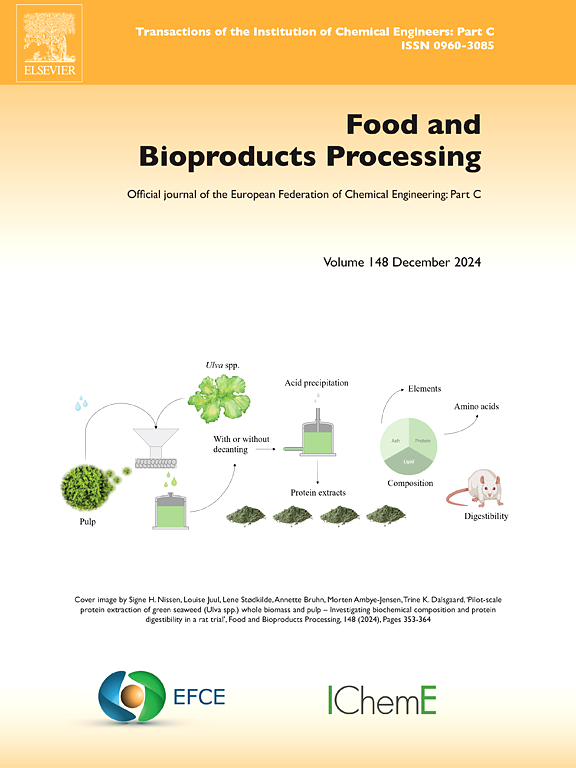Peanut butter adsorption onto surfaces and surfactant selection in cleaning and the effect on allergen recovery
IF 3.5
2区 农林科学
Q2 BIOTECHNOLOGY & APPLIED MICROBIOLOGY
引用次数: 0
Abstract
Stainless steel and High-Density Polyethylene (HDPE) were fouled with suspensions of peanut butter and tested for their cleanability using cleaning solutions containing different surfactants. Following cleaning, protein allergen recovery from the surfaces was determined. The stainless steel was less rough (Sa = 162 nm) and less hydrophobic (-4.5 mJ/m2) than the HDPE surface (Sa = 3261 nm, −61.9 mJ/m2, respectively). HDPE was cleaned more efficiently by Model cleaning solution B than Model cleaning solution A at all concentrations of peanut butter (0.001 % - 10 %). Recovery of the retained protein from the surfaces using Enzyme-Linked Immunosorbent Assay (ELISA) demonstrated that on the stainless steel, regardless of the cleaner or concentration used, no allergen was detected on the surface. The HDPE surfaces detected allergen from surfaces fouled with 10 % and 1 % peanut butter (5.12 ppm – 11.6 ppm and 0.01 ppm – 0.9 ppm, respectively). The recovery of allergens suggests an effect of the surface free energy and size of the surfactant molecules. Such findings are important when considering the selection of cleaners with respect to cleaning and allergen removal.
花生酱在表面的吸附、表面活性剂的选择及对过敏原回收的影响
用花生黄油悬浮液污染不锈钢和高密度聚乙烯(HDPE),并使用含有不同表面活性剂的清洗液测试其可清洁性。清洁后,测定表面的蛋白质过敏原回收率。不锈钢表面的粗糙度(Sa = 162 nm)和疏水性(-4.5 mJ/m2)均低于HDPE表面(Sa = 3261 nm和- 61.9 mJ/m2)。在所有浓度的花生酱中,模型清洗液B比模型清洗液A对HDPE的清洗效率更高(0.001 % - 10 %)。使用酶联免疫吸附试验(ELISA)从表面回收保留的蛋白质表明,在不锈钢上,无论使用哪种清洁剂或浓度,表面都没有检测到过敏原。HDPE表面从沾有10 %和1 %花生酱的表面检测到过敏原(分别为5.12 ppm - 11.6 ppm和0.01 ppm - 0.9 ppm)。过敏原的恢复表明表面活性剂分子的表面自由能和大小的影响。当考虑选择清洁和去除过敏原的清洁剂时,这些发现是重要的。
本文章由计算机程序翻译,如有差异,请以英文原文为准。
求助全文
约1分钟内获得全文
求助全文
来源期刊

Food and Bioproducts Processing
工程技术-工程:化工
CiteScore
9.70
自引率
4.30%
发文量
115
审稿时长
24 days
期刊介绍:
Official Journal of the European Federation of Chemical Engineering:
Part C
FBP aims to be the principal international journal for publication of high quality, original papers in the branches of engineering and science dedicated to the safe processing of biological products. It is the only journal to exploit the synergy between biotechnology, bioprocessing and food engineering.
Papers showing how research results can be used in engineering design, and accounts of experimental or theoretical research work bringing new perspectives to established principles, highlighting unsolved problems or indicating directions for future research, are particularly welcome. Contributions that deal with new developments in equipment or processes and that can be given quantitative expression are encouraged. The journal is especially interested in papers that extend the boundaries of food and bioproducts processing.
The journal has a strong emphasis on the interface between engineering and food or bioproducts. Papers that are not likely to be published are those:
• Primarily concerned with food formulation
• That use experimental design techniques to obtain response surfaces but gain little insight from them
• That are empirical and ignore established mechanistic models, e.g., empirical drying curves
• That are primarily concerned about sensory evaluation and colour
• Concern the extraction, encapsulation and/or antioxidant activity of a specific biological material without providing insight that could be applied to a similar but different material,
• Containing only chemical analyses of biological materials.
 求助内容:
求助内容: 应助结果提醒方式:
应助结果提醒方式:


